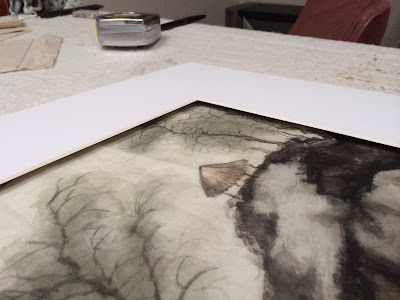After the initial euphoria had subsided, I stepped back and began my self critique phase.
I need better looking lower limbs on that horse.
I started with the same basic outline of the animal, but with a broader stroke. I was going for sort of a boneless brush stroke, creating more of a silhouette than outlines. I was hoping this would make my brush more expressive.
I was treating the lower shanks more like a calligraphy stroke; with discrete stops and lifts and pressure variation. I also pre-wet my brush with alum solution. As you recall from all my toying with alum solution, I was going for that discrete white margin around the brush strokes. As I overlay and correct my lines, these white margins would give an illusion of muscle groups and tendons. If I was a master in brush painting, I would have left the "white spaces" to my brush but I am not at that level yet. Thus I cheated with my faithful alum solution!
Another thing I need to mention is that I had tried to paint the mane and tail with side tip strokes and they just don't look right. After I looked at Xu Beihong's horses, I realized that they should be done with center tip brush strokes. Since the lines go every which way, it is important to rotate the shaft of the brush such that the tip is always lined up with the changes in direction, thus maintaining the center tip attitude.
Side tip strokes
Center tip strokes
This is the revised version of my horse. I am certain we can still find fault with my techniques and craftsmanship, but I am happy with the expression and the feeling the painting conveys. I especially appreciate the neck and head movement.
I sense that the horse is speaking to me. This is a Happy-Go-Lucky horse. This is a horse with that Joie de vivre swagger.
Wishing you all the same!



























